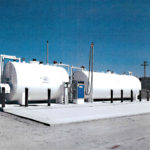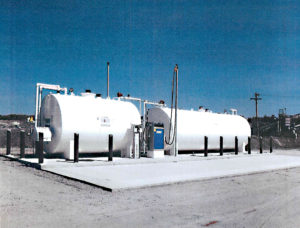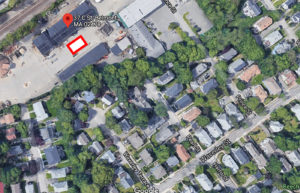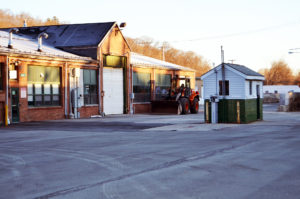
Local Residents Challenge Tank Location, Planning
By Judith Ananian Sarno and Lisa Oteri
At a cost of over $500,000, Belmont is launching an initiative to replace two underground storage fuel tanks located at the Department of Public Works (DPW) yard adjacent to a residential neighborhood—but local residents still have many questions about the tanks’ effect on the neighborhood, and whether the tanks should be in that location at all. The current tanks, which serve Belmont’s fleet of vehicles, need to be replaced as they are single walled and no longer comply with state regulations and are no longer insurable. Town officials have proposed replacing the underground tanks with two 6,000-gallon above-ground tanks, one for gasoline and one for diesel fuel.
The tanks will be placed in the DPW yard, approximately 75 feet from the nearest residential property. The current underground fuel tanks are not visible to neighbors. In June 2020, Town Meeting approved the Capital Budget Committee’s request to spend more than half a million dollars to replace the existing storage tanks. Because changing the town’s license from below-ground to above-ground tanks requires a public hearing, an initial hearing was held in August 2020. At that hearing, both the Select Board chair and the DPW director stated that underground tanks could no longer be installed and that all new tanks must be installed above ground.

A photograph from the town’s website showing fuel tanks similar to those being proposed. Source: Town of Belmont
The hearing, which lasted only 10 minutes, included no specifics about the project and allowed for only three questions from the public, leaving concerned residents with unanswered questions about schematic diagrams, cost-benefit analysis, lighting, security, traffic, and aesthetics. Following the hearing, several residents researched the matter and found that below-ground tanks are in fact, allowed, so long as they are double-walled. However, this option is not being pursued by the town.
A second and final public hearing was scheduled as a 20-minute agenda item at the Select Board’s February 1, 2021, meeting. In preparation for that hearing, on January 28, the town and consultant engineers hosted an informal neighborhood meeting to review some recently obtained information about the above-ground fuel tanks. At the meeting, it was clear that many details remain elusive including any cost-benefit analyses of above- vs. below-ground tank options, evaluation of alternate locations (distance from residential properties), and whether lighting could affect neighboring homes. While no one questioned the need and urgency of tank replacement, the scale of such a project and proximity to a densely populated residential neighborhood heightens the need for a comprehensive and appropriate planning and approval process.
Belmont is active in historic and environmental preservation and engaged in community path and smart-growth initiatives. Our town should be as thoughtful and forward thinking with any infrastructure project that has the potential to raise safety, environmental, and property concerns.
Resident Safety and Quality of Life
Installing two 6,000-gallon above-ground fuel tanks between two DPW garages, with bulldozers, heavy equipment, and trucks entering and exiting at all hours could pose an unnecessary risk for accidents. A truck backing into the above-ground tanks could cause a catastrophic fire or explosion. The existing tanks are underground and the space is open and allows for easy passage, so the current location does not pose a hazard.
Any research on the pros and cons of above-ground tanks vs. below-ground tanks points out that above-ground tanks should not be sited near high traffic areas. In fact, every town neighboring Belmont has underground fuel tanks, including Cambridge, Watertown, Waltham, Arlington, and Lexington. Above-ground tanks in Concord are located far from residential areas.
If Belmont officials are unwilling to install underground tanks, then an alternative solution would be to install the above-ground tanks at an alternative location, such as the town’s incinerator site. That site is a town property reserved for municipal use, and it does not abut a densely populated area.
At this time, our national leaders in Washington, our state governor and legislature, town officials, and many community leaders in Belmont have identified climate change as one of the greatest threats to our planet and have pledged to implement strategies to mitigate its effects. Among the local strategies to combat climate change is to reduce the use of fossil fuels by converting the town’s fleet to electric vehicles. Given that objective, why would our town officials elect to install two new 6,000-gallon tanks, at a cost of more than $500,000, for internal combustion vehicles if they are likely to be replaced by electric vehicles in coming years? Would it not be wiser to seek less expensive alternatives such as smaller, dual-use (gasoline/diesel) underground tanks, and invest in alternative fuel solutions in anticipation of fleet conversion?

The location of the proposed above-ground tanks, outlined below the place marker. Source: Google Maps / Meg Muckenhoupt.
Smart Growth and Development
The proposed tanks will be located adjacent to the South Pleasant Street corridor, an area frequently pointed to as providing commercial and possibly multi-unit residential development. The tanks would threaten the area’s development potential and would be inconsistent with Belmont’s “Town of Homes” image.
Moreover, the DPW facilities will require replacement within 10 years. Several Massachusetts communities have redeveloped their public works facilities with neighborhood-friendly designs for buildings, fencing, and greenery. By contrast, Belmont seeks to install visible fuel tanks near residents’ homes without a 10-year plan for the large DPW property. The town should seek forward-thinking and low-impact solutions which reduce, not increase, blight and fit within a larger environment- and resident-friendly plan.
Use of Scarce Financial Resources
It is not clear that the proposed plan will be the most cost-effective option. Would the cost to replace the old tanks with new double-walled below-ground unit(s) be significantly greater? Are there opportunities for shared resources with other towns or even private partnerships with service stations? Belmont’s citizens simply have not been provided with enough information to know what is best.
Select Board Response
Jay Marcotte, Belmont’s Director of Public Works, provided some summary numbers concerning the cost difference between above-ground and below-ground tanks at a February 1 Select Board meeting. He stated that below-ground tanks would cost about $90,000 more, and that the required monthly inspections for Belmont’s current underground tanks costs $700. He did not offer detailed cost breakdowns for the two options and suggested that such information could only become available after a project was put out to bid. It is apparent that no research was conducted to understand these costs more fully in the five months since the August public hearing was conducted.
The Select Board, accompanied by several town leaders and two engineers from the town’s consultant on the project, Weston & Sampson, responded to questions raised by neighbors and concerned citizens over the past several months.
According to Epstein, locating tanks at the incinerator site, where there is no infrastructure or utilities, would subject police, fire, and highway vehicles that need fuel to a four-and-a-half mile round trip on busy traffic on Mill Street and possible delays. He also stated that electric vehicles will not replace police cruisers, fire trucks, or snow plows anytime soon, so fossil fuel will be required for the foreseeable future.
Marcotte presented diagrams showing that the tanks should not be visible above the existing roof lines of the DPW buildings on the site. However some nearby homes are are at a higher elevation than the DPW, a perspective that was not taken into account. Concerns over lighting from the site leaking onto abutting properties, positioned at a higher elevation than the DPW, will be examined by DPW staff.
Marcotte described the planned above-ground tanks’ safety features. The tanks carry a UL 2085 rating with a two-hour fire rating—meaning that it should take two hours of being engulfed in flames before the inner wall of the tank gets hot enough to be damaged. Expansion valves and fire suppression gear will be installed. They have been ballistics-tested with rifle fire. No data could be found on the potential blast radius of exploding tanks.
Glenn Clancy, Belmont’s Director of Community Development, stated at the February 1 public hearing that an above-ground tank could be located only within two small areas at the incinerator site because the rest of the site will be capped to contain landfill material, in accordance with a state Department of Environmental Protection mandate. He also indicated that the entire incinerator site is close to a wetland area, and therefore would likely require permitting from the Belmont Conservation Commission.
How Are We Planning for the Future?
Currently, Belmont is facing a $6.4 million property tax override on the April ballot. The town’s financial resources need to be spent carefully, fairly, and as part of a comprehensive plan. To spend $500,000 on an initiative that may not be the best solution makes no sense. At the very least, residents with increasing property tax burdens have the right to expect that the town will consider low-impact development solutions that shield residents from risk, blight, noise, and pollution, and promote our town’s environmental values.
Beyond merely the concerns about two fuel tanks, does Belmont have the capacity to fully realize a comprehensive and equitable future for the town? Do we scrutinize a development in one part of town and rubber stamp another across town because we have lower standards or expectations? A solution that works outside of Belmont is not necessarily the best fit for Belmont. A rigorous and comprehensive planning process that inspires public confidence is the best investment in Belmont’s future.
Lisa Oteri and Judith Ananian Sarno are both Precinct 3 Town Meeting members and resident advocates.



Sorry, the comment form is closed at this time.